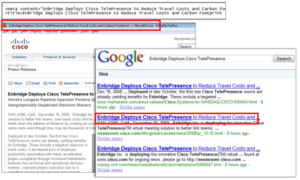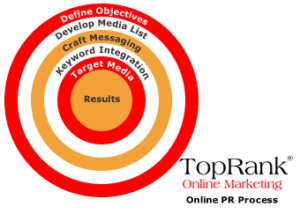Press Release SEO has been one of the most popular topics to attract Google search traffic here on Online Marketing Blog. We’ve seen the ups and downs in the Public Relations industry over the years and have helped inform many Public Relations professionals on the finer arts of SEO by speaking at events like PRSA, providing training for PR agencies and corporate communications departments and writing about the topic here.
After seeing the nice write up by Adam Sherk on Ragan on how to write press releases Google will love, I decided to curate a list of our own Press Release Optimization tips and share them with you. Plus Lee’s added a few more at the end of this post.
Essential Press Release Optimization Tips
Multiple studies have concluded that both consumers and journalists search for and read press releases. By optimizing your press release for a specific audience the content will be easier to find and therefore attract new traffic and brand recognition . This post provides a useful checklist and process for creating a better optimized press release.
4 Tips for Getting PR Approval on Optimized Press Releases
Integration of approved news and SEO keywords can be a daunting task. Including Public Relations in early in the process can help alleviate problems related to SEO approval. This post includes 4 essential tips to ensure that your optimization recommendations can be approved and impact your SEO program.
Lowdown on Press Release Optimization
Clever copywriting may not always be a best practice approach for optimizing press releases. Why? The objective of a press release should be to present a well written article which contains relevant keywords pertaining to the audience that you are trying to reach.
Press Release Optimization and Blogger Relations
The hardest part of news optimization is not always the optimization, it is the measurement. Traditional PR is becoming more and more difficult as major organizations are shutting their doors or laying off employees. An online PR strategy encourages sharing and creates a larger audience base for your news releases.
3 Reasons PR & Communications Need to Know SEO
An understanding of the needs of their “customer’s customer” has always been a very essential piece for PR agencies to remain relevant and productive. Now with the added element of an online strategy it becomes even trickier. This post dives into 3 ways that PR professionals can continue to provide value through a better understanding of optimizing press releases and news.
Takeaways from Lee:
[Note from Lee: Thanks to Ashley for curating some of our advice on Press Release SEO that we’ve given over the years. The SEO tips in these posts are pretty much timeless but the increasing influences of Social Media must also be factored in to create news release content that matters to intended audiences and that inspires them to share and link. In addition to the tips for optimizing press releases above, here are a few things worth considering:]
1. Research Google News specific keywords using Ubersuggest. Other keyword research tools like WordTracker and Wordstream focus on general search engines, but why not find out what’s popular on Google News as well?
2. Focus on a single keyword phrase and 1-3 variations per release. Most important keywords should be first in the title, but not at the expense of a compelling title. Optimize for customers first.
3. Always include an image and attach other useful images using keywords in the file names and annotations.
4. Include video as an embedded element of the release if you can. More engaging content means more shares and reach to attract links.
5. Promote your press release through a distribution service which is very SEO friendly and effective not just because TopRank provides them with SEO advice, but because they are committed to being a great resource for small business marketers and PR professionals.
6. Syndicate and promote the RSS feed of your newsroom (assuming you publish a RSS feed) as well as the RSS feed provided by the press release distribution service. Example tools for this include: Pingomatic, Twitter Feed and posting short form or summary versions of the release with a link to it via Facebook, Google+, LinkedIn and other relevant social channels. Monitor social shares of the release and respond accordingly.
7. Write your news as an article. Try experimenting with creating a timely and newsworthy article format for your news release vs. traditional press release style. It might inspire more editorial pickups and links.
8. Create a series of press releases. Don’t treat your release like a one night stand. Build awareness and momentum with news distribution by creating a series of press releases or at least coordinating releases with other content marketing and online PR efforts over time. One press release is NOT a silver bullet.
9. Archive press releases on your site using keyword categories. Chronological organization of past press releases is only useful for a short period of time. But if releases can be tagged with keywords and associated with topical categories relevant to your business and the interests of the media and your customers, then they also become useful to search engines that can surface those releases where people are looking.
10. Link to press releases from other media and content. When you publish case studies, white papers, reports and ebooks, consider linking to a relevant press release. Many of those types of documents are MS Word or PDF format and you can embed links within that can be found by search engines. White papers and ebooks are often shared socially and re-published on other websites and blogs. Your document hosted on another domain name that includes links back to relevant press releases can provide a strong signal to search engines for better rankings.
What press release optimization tips have you found useful? Are you including press release SEO as part of Online PR or Content Marketing?







